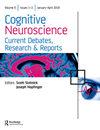21世纪注意力经济中的情绪转换。
IF 2.2
4区 医学
Q3 NEUROSCIENCES
引用次数: 0
摘要
在认知神经科学实验中使用自然刺激激发并需要理论基础,将不同的认知领域,如情感、语言和道德结合在一起。通过放大我们今天经常感知情感信息的数字环境,并受到混合和模糊情感和道德模型的启发,我们在这里认为,在21世纪,成功处理情感信息往往不仅依赖于模拟和/或心理化,还依赖于执行控制和注意力调节。本文章由计算机程序翻译,如有差异,请以英文原文为准。
Switching between emotions in the twenty-first century attention economy.
The use of naturalistic stimuli in cognitive neuroscience experiments inspires and requires theoretical foundations that bring together different cognitive domains, such as emotion, language, and morality. By zooming in on the digital environments in which we often perceive emotional messages today, and inspired by the Mixed and Ambiguous Emotions and Morality model, we here argue that successfully processing emotional information in the twenty-first century will often have to rely not only on simulation and/or mentalizing, but also on executive control and attention regulation.
求助全文
通过发布文献求助,成功后即可免费获取论文全文。
去求助
来源期刊

Cognitive Neuroscience
NEUROSCIENCES-
CiteScore
3.60
自引率
0.00%
发文量
27
审稿时长
>12 weeks
期刊介绍:
Cognitive Neuroscience publishes high quality discussion papers and empirical papers on any topic in the field of cognitive neuroscience including perception, attention, memory, language, action, social cognition, and executive function. The journal covers findings based on a variety of techniques such as fMRI, ERPs, MEG, TMS, and focal lesion studies. Contributions that employ or discuss multiple techniques to shed light on the spatial-temporal brain mechanisms underlying a cognitive process are encouraged.
 求助内容:
求助内容: 应助结果提醒方式:
应助结果提醒方式:


